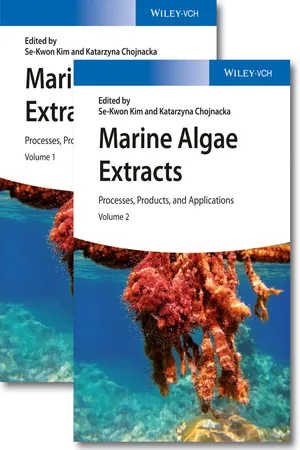Biological Sciences
Diatoms
Diatoms are a type of algae known for their intricate silica cell walls, which give them a unique glass-like appearance. These single-celled organisms are a crucial component of marine and freshwater ecosystems, playing a significant role in the global carbon cycle by producing a substantial amount of oxygen through photosynthesis. Diatoms are also important as primary producers, forming the base of many aquatic food webs.
Written by Perlego with AI-assistance
Related key terms
2 Key excerpts on "Diatoms"
- eBook - ePub
- Mihai Irimia-Vladu, Eric D. Glowacki, Niyazi S. Sariciftci, Siegfried Bauer(Authors)
- 2017(Publication Date)
- Wiley-VCH(Publisher)
5 [3], although their classification and taxonomy is still debated [4].Images of silica shells of various Diatoms.Figure 11.1These microorganisms are unique in the unicellular algae world and are attractive for applications in nanotechnology because of their nanostructured rigid cell wall, calledfrustule, made of amorphous hydrated nanoporous silica. The frustule constrains and encloses the eukaryotic protoplast, protecting it from the aqueous environment and from dangerous light wavelengths and, at the same time, controls nutrient uptake and secretion of cellular products through an intricate pattern of pores and slits on its surface. The frustule looks like a micro pillbox composed of two valves (the epitheca and the hypotheca), connected by lateral rings (girdles) that confer flexibility to the structure (Figure 11.2 ) [5]. Owing to their unique structure, Diatoms have been defined as “living cells in glass houses” [2b].Schematic cross section through a box-like diatom frustule (G, girdle bands).Figure 11.2Both valves and girdles have a specie-specific “layer-by-layer” hierarchical architecture in which every layer has a periodic nanotexturized topography with an ordered disposition of pores (areolae) whose diameter increases passing from the internal to the external layers. In spite of the fluctuation in higher taxonomic categories, a classification of Diatoms can be made on the basis of frustule shape and symmetry of pore patterns: centric are all Diatoms whose frustule has radial symmetry, while pennate are those in which valves are bilaterally symmetric [6]. A schematic three-dimensional (3D) cross section of a frustule of centric Diatoms is shown in Figure 11.3 - eBook - ePub
Marine Algae Extracts, 2 Volume Set
Processes, Products, and Applications
- Se-Kwon Kim, Katarzyna Chojnacka(Authors)
- 2015(Publication Date)
- Wiley-VCH(Publisher)
Asterionella). The Diatoms are more than 40 different types of species on micro-algae isolated in different parts of the world. The 8 major classes and 32 genera of cultured algae are currently used to feed for aquatic organisms.Diatoms are classified into two categories based on frustule regularity: pennate and centric forms. Pennate forms display joint symmetry and tend to inhabit benthic microalgal assemblages and centric Diatoms are radically symmetrical.Diatom cells are covered with a cell wall made up of silica (hydrated silicon dioxide) called frustules . These frustules show a wide diversity in form, but are usually almost bilaterally symmetrical. The symmetry is not perfect since one of the valves is slightly larger than the other allowing one valve to fit inside the edge of the other. Identification of a marine diatom morphology is done using a light microscope and DNA sequencing, especially for the molecular structure. Various assessments and tests to explore the potential for molecular-based diatom identification in the diatom flora of Berlin [2] and 541 taxa are mentioned in Lake Tegel [3], and 18S region is going to be amplified for investigation, as this marker has most often been used for phylogenetic analyses.Salts and nutrients contain trace amount of metals or other contaminants that may inhibit diatom species. In addition, trace metal impurities in major salt solutions prepared from reagent grade chemicals may exceed the nominal metal concentrations of some media. In these cases, it is necessary to remove impurities from the chemical reagents by the passing of macronutrients and some of micronutrients through a resin Chelex 100 column (Bio-Rad Laboratories) [4]. Diatom is a bioindicator of pollution, acidification, and sterilization in routine water quality assessments.Axenic (bacterial free) cultures are essential for studies on the specific skin of diatom. Axenic cultures employ physical and chemical methods for separating bacteria from the Diatoms cells. Treatment of diatom and isolation of individual diatom cells for monoclonal culturing are done using an unusual antibiotic [5–10]. The identification of diatom taxonomy [11], ribosomal sequences [12], and more characteristically diatom morphology, shape of frustules, and extracellular silica cell walls have been done by Mann et al. [13] and Karthick et al. [14]. In diatom culture, identification of normal and abnormal cells is very important; this work was carried out by Falasco et al
Learn about this page
Index pages curate the most relevant extracts from our library of academic textbooks. They’ve been created using an in-house natural language model (NLM), each adding context and meaning to key research topics.

